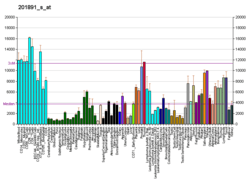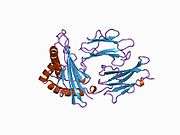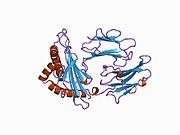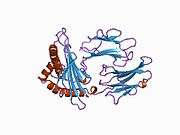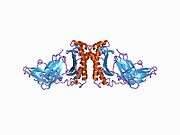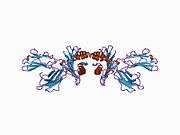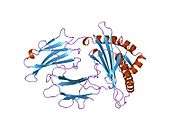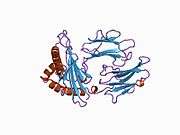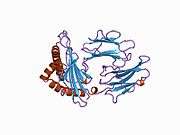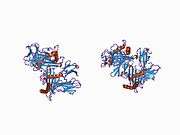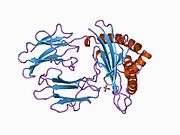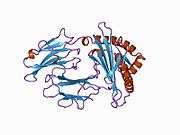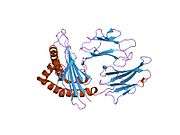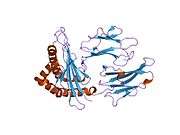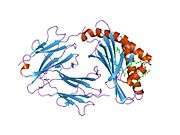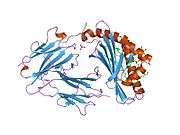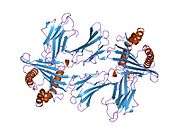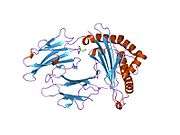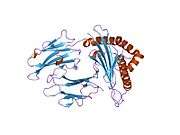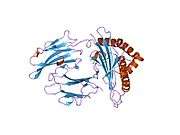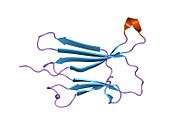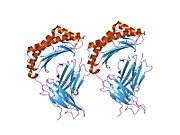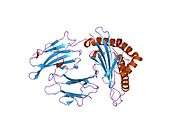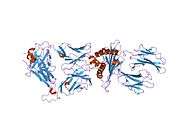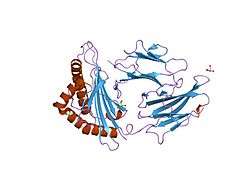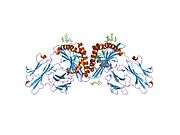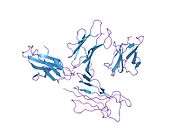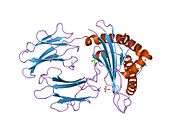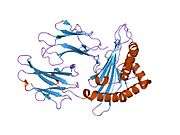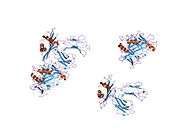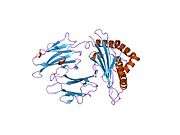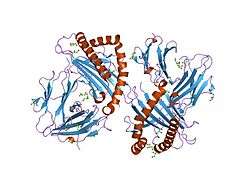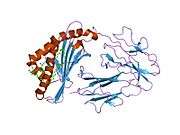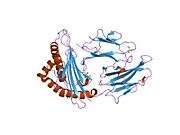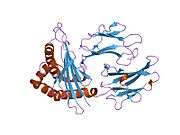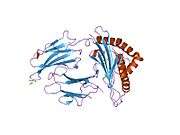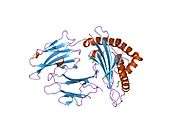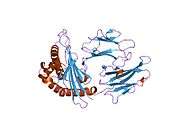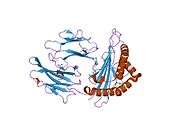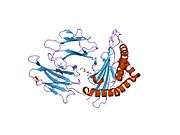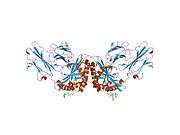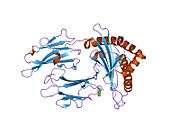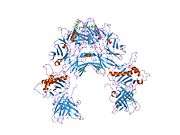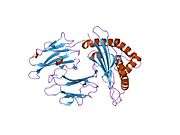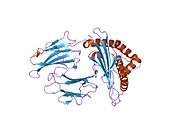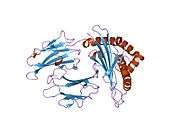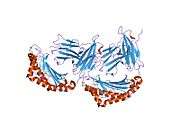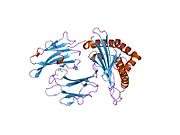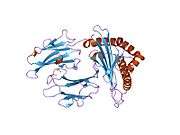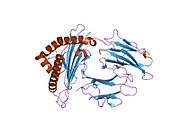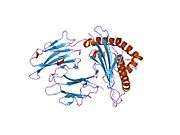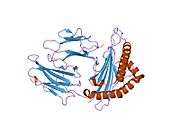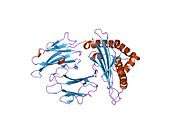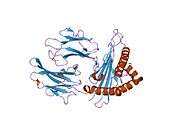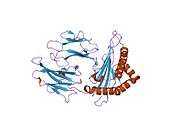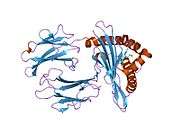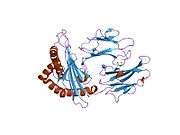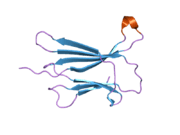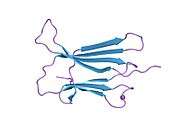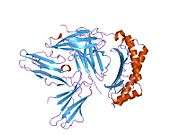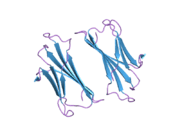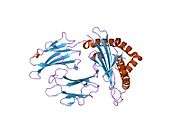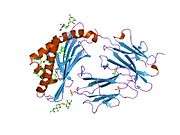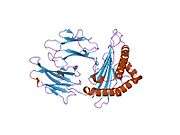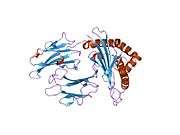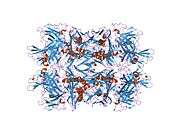Beta-2 microglobulin
β2 microglobulin also known as B2M is a component of MHC class I molecules, which are present on all nucleated cells (excludes red blood cells).[3][4] In humans, the β2 microglobulin protein[5] is encoded by the B2M gene.[4][6]
Structure and function
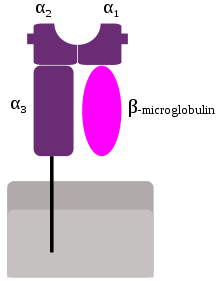
β2 microglobulin lies beside the α3 chain on the cell surface. Unlike α3, β2 has no transmembrane region. Directly above β2 (that is, further away from the cell) lies the α1 chain, which itself is next to the α2.
β2 microglobulin associates not only with the alpha chain of MHC class I molecules, but also with class I-like molecules such as CD1 and Qa.
An additional function is association with the HFE protein, together regulating the expression of hepcidin in the liver which targets the iron transporter ferroportin on the cytoplasmic membrane of enterocytes and macrophages for degradation resulting in increased iron uptake from food and decreased iron release from recycled red blood cells in the MPS (mononuclear phagocyte system) respectively. Loss of this function causes iron excess and hemochromatosis.
Mice models deficient for the β2 microglobulin gene have been engineered. These mice demonstrate that β2 microglobulin is necessary for cell surface expression of MHC class I and stability of the peptide binding groove. In fact, in the absence of β2 microglobulin, very limited amounts of MHC class I (classical and non-classical) molecules can be detected on the surface. In the absence of MHC class I, CD8 T cells cannot develop. (CD8 T cells are a subset of T cells involved in the development of acquired immunity.)
Clinical significance
In patients on long-term hemodialysis, it can aggregate into amyloid fibers that deposit in joint spaces, a disease, known as dialysis-related amyloidosis.
Low levels of β2 microglobulin can indicate non-progression of HIV.
Levels of β2 microglobulin can be elevated in multiple myeloma and lymphoma, though in these cases primary amyloidosis (amyloid light chain) and secondary amyloidosis (amyloid associated protein) are more common. The normal value of β2 microglobulin is <2 mg/L.[7] However, with respect to multiple myeloma, the levels of β2 microglobulin may also be at the other end of the spectrum. Diagnostic testing for multiple myeloma includes obtaining the β2 microglobulin level, for this level is an important prognostic indicator. As of 2011 A patient with a level <4 mg/L is expected to have a median survival of 43 months, while one with a level >4 mg/L has a median survival of only 12 months.[8] β2 microglobulin levels cannot, however, distinguish between monoclonal gammopathy of undetermined significance (MGUS), which has a better prognosis, and smouldering (low grade) myeloma.[9][10]
Loss-of-function mutations in this gene have been reported in cancer patients unresponsive to immunotherapies.
References
- ↑ "Human PubMed Reference:".
- ↑ "Mouse PubMed Reference:".
- ↑ "Entrez Gene: Beta-2-microglobulin".
- 1 2 Güssow D, Rein R, Ginjaar I, Hochstenbach F, Seemann G, Kottman A, Ploegh HL (1 November 1987). "The human beta 2-microglobulin gene. Primary structure and definition of the transcriptional unit". J. Immunol. 139 (9): 3132–8. PMID 3312414.
- ↑ Cunningham BA, Wang JL, Berggård I, Peterson PA (November 1973). "The complete amino acid sequence of beta 2-microglobulin". Biochemistry. 12 (24): 4811–22. PMID 4586824. doi:10.1021/bi00748a001.
- ↑ Suggs SV, Wallace RB, Hirose T, Kawashima EH, Itakura K (November 1981). "Use of synthetic oligonucleotides as hybridization probes: isolation of cloned cDNA sequences for human beta 2-microglobulin". Proc. Natl. Acad. Sci. U.S.A. 78 (11): 6613–7. PMC 349099
 . PMID 6171820. doi:10.1073/pnas.78.11.6613.
. PMID 6171820. doi:10.1073/pnas.78.11.6613. - ↑ Pignone M, Nicoll D; McPhee SJ (2004). Pocket guide to diagnostic tests (4th ed.). New York: McGraw-Hill. p. 191. ISBN 0-07-141184-4.
- ↑ Munshi NC, Longo DL, Anderson KC (2011). "Chapter 111: Plasma Cell Disorders". In Loscalzo J, Longo DL, Fauci AS, Dennis LK, Hauser SL. Harrison's Principles of Internal Medicine (18th ed.). McGraw-Hill Professional. pp. 936–44. ISBN 0-07-174889-X.
- ↑ Rajkumar S. V. "MGUS and Smoldering Multiple Myeloma: Update on Pathogenesis, Natural History, and Management." Hematology, American Society of Hematology Education Program. doi: 10.1182/asheducation-2005.1.340 (ASH Education Book January 1, 2005 vol. 2005 no. 1 340-345) Accessed 23 May 2014.
- ↑ Bataille R. and Klein B. "Serum levels of beta-2 microglobulin and interleukin-6 to differentiate monoclonal gammopathy of uncertain significance." Blood 1992 80(9) p2433 Accessed 23 May 2014.
Further reading
- Huang WC, Havel JJ, Zhau HE, Qian WP, Lue HW, Chu CY, Nomura T, Chung LW (2008). "β2-Microglobulin Signaling Blockade Inhibited Androgen Receptor Axis and Caused Apoptosis in Human Prostate Cancer Cells". Clin. Cancer Res. 14 (17): 5341–7. PMC 3032570
 . PMID 18765525. doi:10.1158/1078-0432.CCR-08-0793.
. PMID 18765525. doi:10.1158/1078-0432.CCR-08-0793. - Huang WC, Wu D, Xie Z, Zhau HE, Nomura T, Zayzafoon M, Pohl J, Hsieh CL, Weitzmann MN, Farach-Carson MC, Chung LW (2006). "Beta2-microglobulin is a signaling and growth-promoting factor for human prostate cancer bone metastasis". Cancer Res. 66 (18): 9108–16. PMID 16982753. doi:10.1158/0008-5472.CAN-06-1996.
- Winchester JF, Salsberg JA, Levin NW (2004). "Beta-2 microglobulin in ESRD: an in-depth review". Advances in renal replacement therapy. 10 (4): 279–309. PMID 14681859. doi:10.1053/j.arrt.2003.11.003.
- Krangel MS, Orr HT, Strominger JL (1980). "Assembly and maturation of HLA-A and HLA-B antigens in vivo". Cell. 18 (4): 979–91. PMID 93026. doi:10.1016/0092-8674(79)90210-1.
- Okon M, Bray P, Vucelić D (1992). "1H NMR assignments and secondary structure of human beta 2-microglobulin in solution". Biochemistry. 31 (37): 8906–15. PMID 1390678. doi:10.1021/bi00152a030.
- Guo HC, Jardetzky TS, Garrett TP, et al. (1992). "Different length peptides bind to HLA-Aw68 similarly at their ends but bulge out in the middle". Nature. 360 (6402): 364–6. PMID 1448153. doi:10.1038/360364a0.
- Gattoni-Celli S, Kirsch K, Timpane R, Isselbacher KJ (1992). "Beta 2-microglobulin gene is mutated in a human colon cancer cell line (HCT) deficient in the expression of HLA class I antigens on the cell surface". Cancer Res. 52 (5): 1201–4. PMID 1737380.
- Saper MA, Bjorkman PJ, Wiley DC (1991). "Refined structure of the human histocompatibility antigen HLA-A2 at 2.6 A resolution". J. Mol. Biol. 219 (2): 277–319. PMID 2038058. doi:10.1016/0022-2836(91)90567-P.
- Caruana RJ, Lobel SA, Leffell MS, et al. (1991). "Tumor necrosis factor, interleukin-1 and beta 2-microglobulin levels in chronic hemodialysis patients". The International journal of artificial organs. 13 (12): 794–8. PMID 2289831.
- Connors LH, Shirahama T, Skinner M, et al. (1985). "In vitro formation of amyloid fibrils from intact beta 2-microglobulin". Biochem. Biophys. Res. Commun. 131 (3): 1063–8. PMID 2413854. doi:10.1016/0006-291X(85)90198-6.
- Hochman JH, Shimizu Y, DeMars R, Edidin M (1988). "Specific associations of fluorescent beta-2-microglobulin with cell surfaces. The affinity of different H-2 and HLA antigens for beta-2-microglobulin". J. Immunol. 140 (7): 2322–9. PMID 2450918.
- Homma N, Gejyo F, Isemura M, Arakawa M (1989). "Collagen-binding affinity of beta-2-microglobulin, a preprotein of hemodialysis-associated amyloidosis". Nephron. 53 (1): 37–40. PMID 2674742. doi:10.1159/000185699.
- Bataille R, Grenier J, Commes T (1988). "In vitro production of beta 2 microglobulin by human myeloma cells". Cancer Invest. 6 (3): 271–7. PMID 3048575. doi:10.3109/07357908809080649.
- Hönig R, Marsen T, Schad S, et al. (1989). "Correlation of beta-2-microglobulin concentration changes to changes of distribution volume". The International journal of artificial organs. 11 (6): 459–64. PMID 3060434.
- Bjorkman PJ, Saper MA, Samraoui B, et al. (1987). "Structure of the human class I histocompatibility antigen, HLA-A2". Nature. 329 (6139): 506–12. PMID 3309677. doi:10.1038/329506a0.
- Güssow D, Rein R, Ginjaar I, et al. (1987). "The human beta 2-microglobulin gene. Primary structure and definition of the transcriptional unit". J. Immunol. 139 (9): 3132–8. PMID 3312414.
- Cunningham BA, Wang JL, Berggård I, Peterson PA (1974). "The complete amino acid sequence of beta 2-microglobulin". Biochemistry. 12 (24): 4811–22. PMID 4586824. doi:10.1021/bi00748a001.
- Suggs SV, Wallace RB, Hirose T, et al. (1982). "Use of synthetic oligonucleotides as hybridization probes: isolation of cloned cDNA sequences for human beta 2-microglobulin". Proc. Natl. Acad. Sci. U.S.A. 78 (11): 6613–7. PMC 349099
 . PMID 6171820. doi:10.1073/pnas.78.11.6613.
. PMID 6171820. doi:10.1073/pnas.78.11.6613. - Momoi T, Suzuki M, Titani K, et al. (1995). "Amino acid sequence of a modified beta 2-microglobulin in renal failure patient urine and long-term dialysis patient blood". Clin. Chim. Acta. 236 (2): 135–44. PMID 7554280. doi:10.1016/0009-8981(95)06039-G.
- Collins EJ, Garboczi DN, Karpusas MN, Wiley DC (1995). "The three-dimensional structure of a class I major histocompatibility complex molecule missing the alpha 3 domain of the heavy chain". Proc. Natl. Acad. Sci. U.S.A. 92 (4): 1218–21. PMC 42670
 . PMID 7862664. doi:10.1073/pnas.92.4.1218.
. PMID 7862664. doi:10.1073/pnas.92.4.1218. - Matoba R, Okubo K, Hori N, et al. (1994). "The addition of 5'-coding information to a 3'-directed cDNA library improves analysis of gene expression". Gene. 146 (2): 199–207. PMID 8076819. doi:10.1016/0378-1119(94)90293-3.
- Wang Z, Cao Y, Albino AP, et al. (1993). "Lack of HLA class I antigen expression by melanoma cells SK-MEL-33 caused by a reading frameshift in beta 2-microglobulin messenger RNA". J. Clin. Invest. 91 (2): 684–92. PMC 288010
 . PMID 8432869. doi:10.1172/JCI116249.
. PMID 8432869. doi:10.1172/JCI116249.
External links
- beta 2-Microglobulin at the US National Library of Medicine Medical Subject Headings (MeSH)
- Human B2M genome location and B2M gene details page in the UCSC Genome Browser.
